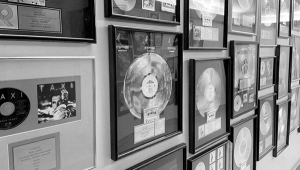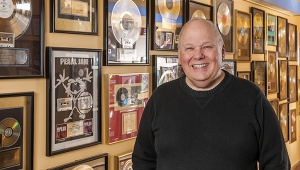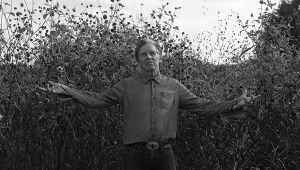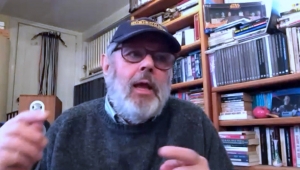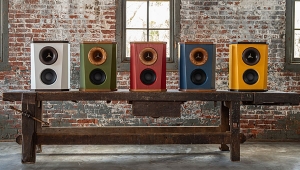| Columns Retired Columns & Blogs |
Making Tubes User-Friendly: Luke Manley of VTL Page 2
"We disagreed vehemently about whether or not to sell direct. We both knew that we had to split up. Dad was ready to move into his new building, so he took the Manley Studio division and the ViTaL Records division, and I kept VTL. We basically split the company down the middle; we split the inventory, the employees—he took the Manley people and I kept the VTL people—everything."
Since the split, Luke has been steadily re-engineering the company and products. One of the first things he did was to spend time with dealers to find out what the company needed to do in terms of products and to build a strong partnership with the dealers. "We focused the line...we eliminated the mail-order dealers, we put into place the programs and policies that we needed, governed by a strict agreement that prohibits any selling out of their area. We put on a feasible five-year warranty that dealers can help us support, and we pay the dealers to do that."
The interaction with dealers and distributors continues, with Luke constantly bouncing between the factory and the road. "I have to catch up. For 12 years, we did almost no traveling. I go to the market and I see what other companies and distributors are doing in the market. I meet the press, I meet dealers and distributors, I get to pitch my lines, I find out which of them are for real and what their strategies are...so that I can find ones who are compatible, whose strategy matches mine."
All of VTL's design, business, and manufacturing practices were evaluated, and revamped or replaced as necessary. A sophisticated computerized MRP2 (Manufacturing Resource Planning) system was installed, which allows virtually every facet of the company's operations to be planned and tracked. Everything—from parts inventory planning to order projection and shipping schedules—is handled by the centralized system.
"The only place everybody turns to is the computer. I have everything in a single database. In the old days, you always had to interrupt a bunch of people until you found the one who could tell you what you needed to know. We never had the right parts at the right time, and ended up building things out of whatever was lying about. People were always getting upset because the stuff had different parts. Now, everything you need, you find on the computer...and we can order parts in much larger quantities and run JIT [just in time] because everything is projected, planned, and tracked."
The products were similarly scrutinized, and under Luke's direction the line has steadily evolved. The first step? "We eliminated all preamps. Our best preamp was the Super DeLuxe, which became the PR-1. We built it and a few of the PR-9s, the Ultimate, while we decided what kind of preamp we really wanted to build. I wanted a completely new design, not just the standard cathode-follower type that many users find dark-sounding; that I find dark-sounding. The second major thing I did was to improve the cosmetics of the amplifiers, just to make a complete break—to say, 'VTL has changed'."
Other changes included dropping the digital components, due to the prohibitive cost of the necessary in-house R&D, and a reevaluation and paring-down of the amplifier line. "We just went through model by model, starting with the 250/450, deciding which should be eliminated, which had to be more buildable. For each one, we redid the board layout, fine-tuned the circuit—things like quiet grounding paths—and improved parts quality in important areas and redesigned for more parts interchangeability. Except for output transformers, where we went the other way. There are major benefits to exactly matching the output transformer to the output tubes' source impedance, which was a big goal of the Signature transformer project. The Signature transformers were a major differentiating point, a major improvement to the sound of VTL."
A key element in the re-engineering is the collaboration with designer Gregg Scott, a Cal-Poly-educated electrical engineer. The relationship began with the Signature transformer project, but quickly expanded to include overseeing the new amplifier-board layouts. The Wotan MB-1250 uses the basic VTL amplifier circuit, but Gregg was the one responsible for the layout and final design. The new preamps are his design from the ground up. As Luke says, "I did the front-end, specifying the circuit topology and the features, deciding on the cosmetics and price points, setting the basic performance specs...and then Gregg did all the serious number crunching to come up with the design. I'd go over it and maybe say, 'That trace needs to be heavier because we're carrying a lot of current,' or 'I know that the design books say that we only need a 10µF capacitor there, but 250µF will sound better.' After 12 years of manufacturing experience, I know what works and what doesn't."
Manufacturability, of course, is now a key part of finalizing any VTL design. Comparing a TL-2.5 to a PR-9 illustrates this point clearly. The new unit's internal workings are obviously much simpler to build, and to build reliably.
One of the most visible aspects of the re-engineering is the change in the products themselves—or rather, the change in the intended product/user relationship, which is the emphasis on "Making Tubes User-Friendly." Gone are the front-panel bias-adjustment systems, ditto for the variable feedback and slope controls. Even the tetrode/triode switch has been moved to the back panel, which is now angled to facilitate attaching speaker cables. The tubes are run conservatively to ensure long life (3500-5000 hours), and VTL suggests checking the bias no more than once or twice a year. A B+ fuse is included to protect the amplifier if a tube fails. Features like remote control and multiple tape/processor loops were included in the preamps and upcoming integrated amp. Even the new cosmetics and logo were selected to be simple and modern, rather than emphasizing the products' thermionic heart.
"The idea is to show people that we're not some gurus building esoteric tube amplifiers. I make amplifiers for people who are music lovers, who can be somewhat afraid of tubes. If they want to see the tubes they can, and if they want to adjust the bias, they can...but they don't have to, they don't even have to think about it. That's the whole idea behind the re-engineering, of making tubes user-friendly. People can just enjoy the music."
- Log in or register to post comments

